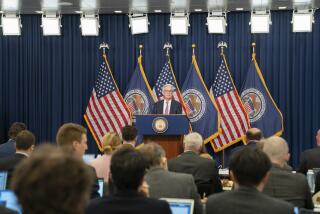AIG bailout was designed to punish insurance giant, Paulson testifies
- Share via
Reporting from washington — The 2008 government bailout of American International Group Inc. was specifically designed to punish the insurance giant, former Treasury Secretary Henry M. Paulson said in U.S. court Monday.
The $85-billion loan package extended to AIG — then reeling from the financial and housing crisis — gave the government control of 80% of its stock. Unlike other major financial firms rescued in the middle of the worst economic downturn in roughly 80 years, Paulson said that AIG shareholders should have faced punishment for their troubled balance sheet as part of any rescue.
Paulson’s testimony came as part of a lawsuit brought by former AIG Chairman and Chief Executive Maurice “Hank” Greenberg. The 89-year-old is suing the federal government for damages of roughly $40 billion, saying that it violated the Constitution’s 5th Amendment by taking control of AIG without “just compensation” in return for the shares.
Paulson’s successor as Treasury secretary, Timothy F. Geithner, and former Fed Chairman Ben S. Bernanke are also scheduled to testify this week.
“I believe the Fed-designed AIG terms were appropriate,” Paulson said in testimony at the U.S. Court of Federal Claims. “I didn’t see any other insurance company that was vulnerable or like AIG.”
Federal officials didn’t want troubled financial institutions to assume they could receive a bailout without any negative consequences. Otherwise, those firms might engage in reckless behavior. This concept known as “moral hazard” applied to AIG but not other banks because of the multiple pressures that existed in the market in September and October of 2008.
At the time, financial investors known as short-sellers were betting that shares in AIG and prominent banks such as Citigroup would continue to plunge. Paulson said that his goal was to stabilize the financial system, which meant that the government offered less punishing terms to the banks being bailed out in order to limit the market freefall. But few other insurers faced the same risks as AIG, so the Federal Reserve-backed loan could punish shareholders to prevent moral hazard, he said.
Greenberg’s lawyer, David Boies, pressed Paulson about whether the former Treasury secretary was overly harsh on AIG in order to quell public anger and pass the Troubled Asset Relief Program. At the time, some members of Congress were reluctant to pass the $700-billion TARP, a program to buy troubled bank assets that could be viewed by critics as a giveaway to Wall Street.
Paulson said he contacted both 2008 presidential candidates — Democrat Barack Obama and Republican John McCain — and emphasized that AIG shareholders were being punished as part of the bailout.
AIG “certainly was a scapegoat for Wall Street and all the bad practices that people were angry about,” Paulson said.
The government eventually provided AIG with $182 billion in loans, which have been repaid. AIG has since returned to profitability, and its stock has risen more than 45% over the past two years to more than $52 a share.
More to Read
Inside the business of entertainment
The Wide Shot brings you news, analysis and insights on everything from streaming wars to production — and what it all means for the future.
You may occasionally receive promotional content from the Los Angeles Times.










